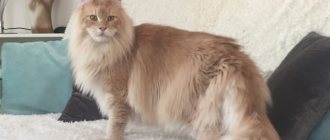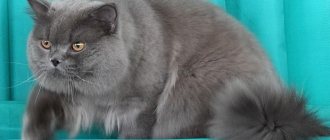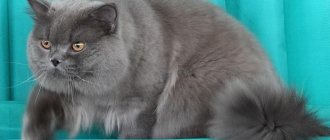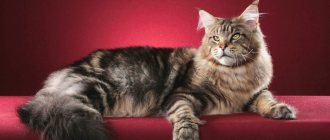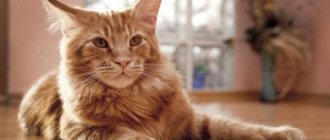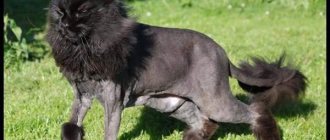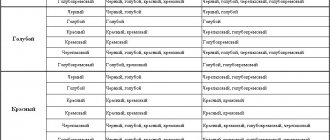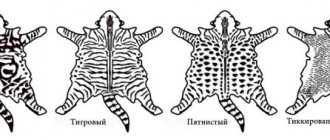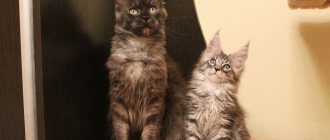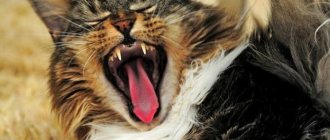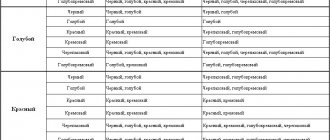Mating of Maine Coons is a very important and responsible period that begins when the grown-up Coon declares his readiness to continue the family - the cats begin to mark the room, the cats meow, rub against vertical objects and roll around on the floor. Maine Coons are ready for mating after the third heat - usually this happens between 10 months and one and a half years. It happens that the first heat occurs earlier - at the age of 7-8 months. The cat reaches its prime at one and a half years, but it is ready to breed from about 8 months.
What do novice owners need to know?
It is not advisable to allow individuals older than two years to mate. Due to their lack of experience, they may develop behavioral problems.
It is best to contact a felinological club, where they will find a “partner” for your pet. Or you can contact the owner of the Maine Coon after meeting him at the exhibition.
Extra forethought in such situations is only welcome, since the intended candidate may well be busy at the right time.
Beginning owners need to know a few nuances before breeding Maine Coons/Yandex Collections
The selected animal must have participated in exhibitions and be rated at least “very good”. Otherwise, the kittens will not be purebred, even if both parents are coons.
Before mating cats and Maine Coon cats, the animal must be vaccinated against a number of different diseases.
Documents are not only whiskers, paws and tail
In order for everything connected with the birth of kittens to go well, mutual understanding is necessary not only between the future coon parents, but also between their owners. Mating of Maine Coons is usually documented. It is necessary to draw up a mating agreement that specifies the obligations of both parties. While the cat is in the cat’s territory, the owner of the Maine Coon bears full responsibility for it. The contract specifies the names of the Maine Coons, the owners of the animals and their addresses. The document is signed by both parties. It contains information about the health status of Maine Coons, mating conditions, fees for mating, and also discusses the procedure for a failed mating. The contract specifies the costs of keeping kittens and the procedure for their registration and documentation.
Payment
Usually, for mating, the cat owner receives a fixed amount or one kitten from the litter, but he has the right to know all the information about the kittens born as a result of mating. When only one kitten is born, the owner of the coon cat receives half the price of the kitten upon sale.
If mutually desired, animal owners can stipulate a different payment method in the contract. A mating agreement helps to avoid conflict situations that often arise when dividing offspring between owners of parent coons.
Owners of breeding Maine Coons often keep records where they note not only the mating dates and names of the animals, but also the color and behavioral characteristics of the cats. Often this information is indicated in the female's veterinary passport. This is necessary for the optimal selection of pairs from which healthy offspring are born with a sought-after color and well-defined breed characteristics.
Preparation
The nervous system of cats is also not made of iron, so it is better to bring the female Maine Coon to a potential partner in advance so that she becomes familiar with the situation. It's better to do this in a couple of days. It is also important that future parents get to know each other in advance.
Despite the fairly fast mating process in cats, it is recommended that Maine Coons be given plenty of time for mating, since certain difficulties with communication may arise. So, this can take from several hours to a day.
You need to bring the cat to the cat's owner's house on the second day of estrus. You should also take all the female’s things: food, dishes, tray. It is important to take care of the documents and take a copy of the pedigree with you.
How successful the process will be can be determined by the cat’s behavior. If he does not show any interest in a potential partner, the mating will not take place.
Advice! Before mating, trim your pets' nails to prevent them from scratching themselves during interaction.
For an experienced female, you can select any male, and vice versa. It should be remembered that after the first meeting the cat does not always manage to become pregnant.
If the result was not achieved, after some time you need to organize another date with the same male.
Mating Maine Coons can take from several hours to a day/Yandex Collections
Natural nutrition
Preparing food for your Maine Coon yourself is considered a very good way to raise a healthy and large cat, but it has 2 disadvantages: it is time-consuming and requires careful consideration of nutrients. But feeding Maine Coon kittens traditionally occurs in this way - the owners develop a balanced menu and carefully monitor the quality of the products.
Meat and offal in the Maine Coon diet
Maine Coon food should contain up to 95% protein. In nature, the cat leads a predatory lifestyle and has not yet become an omnivore. For full development, it needs animal (and not plant) protein, the main supplier of which is meat.
During the first 2 months, owners and breeders do not face the question of what to feed the Maine Coon. During this period, the kitten has enough mother's milk. But as soon as he switches to independent feeding, the need immediately arises to provide him with protein of animal origin:
- The best meat varieties for cats are lean beef, rabbit, chicken, and turkey.
- By-products - kidneys, liver, heart, and other offal also contain the necessary types of proteins and should be present in the Maine Coon's diet.
It is advisable to clean all meat components from bones, films, fatty layers, and tendons. Before feeding the cat, the meat is completely frozen. To do this, the product is placed in the freezer for 3-5 days, and then thawed and given to the Maine Coon raw, boiled or doused with boiling water. This preparation algorithm guarantees the death of all parasites that can infect the intestinal microflora and cause negative consequences for the cat’s health. The same applies to all types of by-products, which must be subjected to complete heat treatment.
Fish and fish products
The second source of animal protein for the Maine Coon is fish. However, the presence of fish ingredients in natural diets is controversial. You cannot completely deprive the Maine Coon of this nutritional component, since in nature the cat catches fish on its own. Experts recommend following the following rules:
- At home, Maine Coons receive dishes containing fish no more than 2 times a week.
- Fish dishes should not be separate - the product is offered to the Maine Coon along with vegetables or cereals.
- Large and small bones are removed.
- Cod, pollock, sprat, herring (other cheap varieties) have little nutritional value, but urolithiasis and other related cat ailments develop from their consumption. Therefore, it is not recommended to feed them to a Maine Coon kitten (from 3 months to six months).
- Salted fish should be completely excluded from the diet.
Despite all the prohibitions and restrictions, fish is considered an extremely valuable product in the Maine Coon’s natural diet. In addition to protein, it supplies the body with fats, vitamins and microelements.
Can Maine Coons have milk and eggs?
A chicken egg must be present in a cat’s diet, but it must be given once a week. It is preferable to feed the animal only the yolk. It contains the element biotin (vitamin B), which is extremely valuable for metabolism. A one-time weekly intake of this component is enough to maintain the desired balance of substances in the body, regardless of how many times a day the Maine Coon eats and what the size of its portions.
It is believed that all cats love milk, but its role in natural nutrition should not be overestimated:
- You can feed a Maine Coon kitten with whole cow's milk for no more than 3-4 months, after which this product is no longer absorbed by the body.
- Goat's milk is great for both large and small cats - you can give chicken protein along with it.
- Fermented milk products work great in a natural menu: sour cream, yogurt, kefir, yogurt, cheese, cottage cheese (low fat content).
All dairy products are used in pure form or mixed with other ingredients. They belong to the section of regular food that you can feed your Maine Coon.
Vegetables, grains and fruits
In order for the Maine Coon to be healthy, a variety of vegetables and fruits must be included in its natural diet. In the natural environment, cats do not receive these products and therefore they are most often included in the menu as part of other dishes. Vegetables, raw or boiled, are chopped (grated) and added to meat and fish. And fruits are most often combined with dairy products.
The picture is the same with cereals. They are fed to the Maine Coon to gain weight and further maintain good physical shape. Oatmeal is steamed, rice and buckwheat are boiled, mixed with meat or fish in a 1:2 ratio and offered to the cat 3-4 times a week. A large cat will not be interested in porridge as a separate dish; Maine Coons are quite loyal to combined food.
Optimal environment for mating
Typically, a closed room with a minimum amount of furniture is chosen for mating. This is done so that the cat, in case of problems with communication, can hide from its boyfriend, but remain in his field of vision.
A heavily crowded room will most likely slow down the process, which in such conditions may not take place at all - the animals will simply get tired and change their plans.
The process can take place in different ways. Some Maine Coons are quite loud, while others are so quiet that it may seem like they are not doing anything at all.
Animal behavior also varies. Some behave quite aggressively, while others, on the contrary, are affectionate in communication.
For breeding Maine Coons, choose an enclosed space / Yandex Collections
Usually human intervention is not required, but there are times when it is necessary. For example, if a cat has taken a position that is uncomfortable for the male, she needs to be held in the right position.
Inbreeding as a component of purebred breeding
Inbreeding as a component of purebred breeding
In the course of his work, the breeder must decide which females should be mated with which selected males so that their offspring will combine certain characteristics and acquire improved traits. This selection event is called selection of pairs for crossings. The selection of pairs should be carried out systematically and systematically, and its goal is to change the genetic structure of the animal population of a given nursery in the desired direction or to preserve and consolidate a certain combination of valuable traits in the offspring. Sometimes, to breed new breeds or introduce completely new characteristics into a breed that were not previously characteristic of it, interbreeding or even interspecific crossing is used, but usually the main direction of the breeder’s work is the so-called purebred breeding - mating of individuals of the same breed.
Purebred breeding is divided into two types:
outbreeding is a system of unrelated matings of animals within a breed;
inbreeding is a system of mating of individuals who have a close degree of relationship, such as brother-sister, father-daughter, mother-son, cousins, etc.
In general, inbreeding assumes that the mated individuals - the future father and mother - have common ancestors or at least one common ancestor. Although for specialists the importance and necessity of inbreeding in purebred breeding is obvious, among amateurs there are a lot of myths and prejudices, both against inbreeding itself and against the use of inbred sires in breeding. (We will say in advance that the latter is a particularly big mistake, since inbred selective sires are, as a rule, prepotent - their children turn out to be mostly like their father - and also often produce exceptionally strong offspring.)
Genetic basis of inbreeding
What is the biological (genetic) essence of inbreeding? All modern breeds of animals, including cats, are heterozygous for many genes. This means the following. The zygote - a fertilized egg - receives one complete set of genes from both the father and the mother, so that it has a double set of them. If both genes responsible for a given trait - one from the father and the other from the mother - are identical, then this condition is called homozygous for this gene, and an individual homozygous for this gene will develop from the egg. If the genes of the equivalent pair, for example, those determining the formation of black hair pigment, are different (say, the father passed on the black color gene C, and the mother passed on a modified, for example, Himalayan, cs gene), then the individual will turn out to be heterozygous for this gene (Ccs). In the latter case, the black color gene is dominant, and the animal will be externally (phenotypically) black, but will be a carrier of the recessive (hidden) Himalayan gene. If such a heterozygous animal - let it be a black cat, a carrier of the Himalayan gene - is crossed with its sister, also a black cat, carrying a hidden Himalayan gene, then a split will be observed in the offspring (Fig. 1): part of the offspring will be black in color (CC - homozygous , and Cсs are heterozygous genotypes), and the other part is Himalayan (сссs homozygous genotype). This happens because when crossing this black cat with his black sister, their gamete sex cells (sperm and egg) - carrying a single set of genes, will occur in all four possible combinations: C from cat and C from cat, C from cat and cs from cat, cs from cat and C from cat, cs from cat and cs from cat. Therefore, with a probability of 1/4, two Himalayan genes (one from the father, the other from the mother) will converge in one zygote and give a homozygous Himalayan genotype and, therefore, a Himalayan phenotype in some kittens of the litter. The other part of the litter, with the same probability of 1/4, will be homozygous for the solid black gene (CC). Thus, the genetic essence of inbreeding comes down to the process of decomposition of a population into lines with different homozygous genotypes. Since during inbreeding, genes that were in a heterozygous state pass into a homozygous state; in the next generation, when crossing homozygous animals of the same color, no splitting will be observed. In this way, with the help of inbreeding, hidden traits are identified, desired traits are consolidated in generations, and stable genetic lines are created. The fastest practical way to increase homozygosity in higher animals is to mate siblings who have the same father and mother (it makes no difference whether the sibs are taken from littermates or from different litters), as well as to mate father and daughter or mother to son. The opinion sometimes expressed among non-professionals that, they say, it is possible to mate a father with a daughter, but not a mother with a son, is a myth that has no basis; the effect of both types of inbreeding is exactly the same. If such close inbreeding (incest) is carried out for 16 generations in a row, then 98% homozygosity is achieved for all genes, and therefore, due to the absence of segregation, all individuals of these litters become almost identical in genotype and phenotype - all children are identical, like twins, Of course , in practice, a much smaller degree of inbreeding is usually used, and accordingly a much lower degree of homozygosity is achieved. It should be noted that the mating of second cousins (common great-grandfather) leads to an increase in homozygosity by only 2% over an infinite number of generations. Consequently, inbreeding of this type is already fundamentally different from closer degrees of inbreeding and essentially does not lead to the achievement of the goals that are placed before the system of consanguineous matings. Breeders who, for one reason or another, avoid inbreeding may not be afraid to mate second cousins.
Determination of the degree of inbreeding and inbreeding coefficient
Based on the analysis of the animal's pedigree, it is possible to qualitatively assess the degree of inbreeding, which is expressed by the saturation of the pedigree with common ancestors (nicknames) on the maternal and paternal lines. According to Shaporouge, Roman numerals denote generations (a series of ancestors), counting the parent as the first, grandfather as the second, etc. If a common ancestor is repeated in both the maternal and paternal parts of the pedigree, then its occurrence in the maternal pedigree is indicated first, and then, after a dash, in the paternal pedigree. Then the crossing of son x mother will be designated as I-II, father x daughter as II-I, brother x sister as II-II, grandfather x granddaughter as III-I, cousins x sister as IIIIII, etc. Inbreeding type father x daughter (II-I), son x mother (I-II) and brother x sister (II-II) is designated as very close, or incest; inbreeding type II-III or III-II is close inbreeding; and crossing III-IV, IV-III, IV-IV, II-V, etc., is moderate inbreeding. Due to the lack of perceptible effects, more distant inbreeding may in practice not be considered true inbreeding. Owners of high-quality purebred cats, having picked up the cat's pedigree, can themselves assess how often and to what extent inbreeding was used by the breeders who participated in the breeding of this pet.
To quantitatively take into account the degree of inbreeding in the pedigree of an animal and thereby determine the measure of its homozygosity, the English geneticist S. Wright introduced the concept of inbreeding coefficient (F). This coefficient is calculated as follows. First, the number of generations (arrow - such as in Fig. 2) from the common ancestor A of the father and mother to the father of a given animal (p) is calculated, then the number of generations (arrow) from the same ancestor A to the mother (m). These numbers are summed up, and one is added to the sum: n = p+ m+ 1. The inbreeding coefficient of the analyzed animal (proband X) for this ancestor is equal to 1/2 to the power of n: Ga = (1/2)n. If the father and mother have several common ancestors, then the coefficients are summed up:
Fx =EF, =E(1/2)n,
where i are the common ancestors of A, B, C, etc.
As an example, let’s calculate the inbreeding coefficient of an animal (proband X) obtained from crossing siblings (II-II, Fig. 2c). In the pedigree, the distance (path) from grandfather to father is 1 generation, from grandfather to mother is 1 generation, therefore, n = 1 + 1 + 1 = 3, which means Fв = (1/2)3 = 1/8. But they have one more common ancestor - their grandmother; from her to her father is 1 generation, from her to her mother is 1 generation, and therefore Fa will also be 1/8. The overall inbreeding coefficient for X is Fx = Fa+ Fb = 1/8+ 1/8 = 1/4, or 0.25. Another example is the crossing of a grandfather with a granddaughter (III-I, Fig. 2,e). Here the offspring on the paternal line have no generations (arrows), i.e. 0 generations, on the maternal side - 2 generations, whence n = 0 + 2 + 1 = 3, and then Fx = (1/2)3 = 1/8, or 0.125. Finally, an example with crossing cousins with sister (III-III, Fig. 2, f). The common ancestors of their offspring are their great-grandfather and great-grandmother. From great-grandfather to father - 2 generations, from him to mother 2 generations, i.e. n = 2 + 2 + 1 = 5, and accordingly Fb = (1/2)' 1/32. The same is obtained when calculating the inbreeding coefficient for another common ancestor - great-grandmother: Fa = (1/2)3 = 1/32. Therefore, the total inbreeding coefficient Fx = Fa + Fb = 1/32 + 1/32 = 1/16, or 0.0625. From available pedigrees, each breeder or owner of a purebred animal can calculate the inbreeding coefficient of their pets or their parents and grandparents - if inbreeding was used in their production. As already mentioned, this coefficient is an indicator of the degree of purity (homozygosity) of the lines participating in the pedigree, as well as an indication of the possible prepotency of the corresponding sires and/or female sires (see below). The higher the inbreeding coefficient of an animal, the more of its genes are in a homozygous state. Naturally, as follows from the formula, the inbreeding coefficient cannot exceed one,
Inbreeding depression and heterosis
Why is it that in human society, in most civilizations, there is either a direct ban on incest or condemnation of it? Moreover, why in the wild is everything adapted in such a way as to avoid inbreeding and homozygosity as much as possible? The main reason is that both wildlife and human society require a variety of genotypes and individuals in the population to successfully survive and adapt to changing environmental conditions (including social and economic conditions in the case of human society). In a diverse community there will always be individuals best adapted to a given specific situation; however, the situation is changing - and other individuals, with other signs, float to the surface. The uniformity of a population, although well adapted to the given specific conditions of its existence, dooms a biological species to extinction when conditions of existence change. Thus, the desire to create diversity is necessary not for individual individuals, but for the entire species to meet the various and changing demands of the environment and the historical process . But there is also a direct danger of inbreeding for individual individuals. The fact is that both during the individual life of an animal (and a person), and over generations, mutations—gene changes—occur from time to time. Most mutations are harmful, and if they immediately manifested themselves, they would lead to death (lethal mutations), deformities, abnormal behavior, inconsistencies with the environment, etc. However, most mutations are at the same time recessive in nature, i.e. in combination with a normal paired gene, due to the double set of genes, does not appear in the heterozygous state. The burden of such harmful, but not manifested, hidden mutations is present in every heterozygous individual, including every person. Inbreeding creates homozygosity, including homozygosity for harmful genes, and, consequently, leads to their phenotypic manifestation in the offspring - intrauterine or early death, deformities , reduced viability, etc. This phenomenon is called inbreeding depression. Let's ask the opposite question: why, despite the danger of inbreeding depression, do breeders who breed and improve domestic animals so often resort to inbreeding and are not afraid of it?
The answer is simple: breeders do not strive to ensure maximum survival, vitality and high qualities of all offspring, but select the best, culling (for example, castrating) defective, weak and simply undesirable traits. Thus, during inbreeding, when the genotype is decomposed into homozygous lines, harmful recessive genes appear and are removed from further breeding, and all “good” genes and their combinations are fixed in a homozygous state and left for further generations.
Thus, inbreeding in the hands of a breeder is a way to remove the load of harmful mutations from the genotype and create the necessary combinations of valuable genes and traits. In addition, thanks to homozygosity, the homogeneity necessary for breeding any new breed is created, meeting the requirements of this breed, and the corresponding valuable traits are fixed in the offspring. It should be noted that as inbreeding and selection of the best, due to getting rid of the burden of harmful hidden mutations, the danger of inbreeding depression during inbreeding of selected inbred animals decreases. When crossing between representatives of different independent inbred lines, a phenomenon can be observed that, in a certain sense, is the opposite of inbreeding depression - heterosis, also called “hybrid vigor”. Such hybrids of two inbred animals usually show increased vitality, growth, fertility, etc. This occurs because when crossing between two inbred lines selected and therefore similar in typical characteristics of the breed, homozygosity for these selected characteristics is preserved in the offspring, whereas the remaining harmful mutations that are not rejected are transferred to a heterozygous state and thereby become recessive, i.e. do not appear.
Practice goals of inbreeding
Let us consider in general and summarize the tasks that are performed and the goals that are pursued by livestock breeders, including cat breeders, when using inbreeding. First, inbreeding is necessary when developing a new breed or a new group within a breed. To increase genetic diversity and attract new traits, the breeder crosses animals of different breeds. The resulting hybrid offspring is heterozygous and will therefore produce segregation in subsequent generations. To consolidate the desired combinations of traits, inbreeding is mainly used close, such as brother x sister, father x daughter and mother x son. As a result of inbreeding, homogeneous families are created and a constant manifestation of traits is achieved. Among inbred offspring, up to 80% of the animals are strictly culled - defective, weak and not meeting the intended standards. Secondly, close (very close) inbreeding is used in cases where it is necessary to identify producers who are carriers of lethal, semi-lethal and other undesirable genes. This is the so-called test inbreeding. Based on the results of test inbreeding, various decisions can be made: either such sires are discarded or used to produce homozygous offspring (through inbreeding) with the culling of defective ones and the selection of the best ones, thereby achieving purification of the genotype from unwanted genes. Thirdly, the purpose of inbreeding may be to breed a highly potent producer, that is, one that effectively passes on its traits to children. It is known that inbred animals have a higher individual prepotency compared to individuals obtained from unrelated crosses. Because of this, it is a widely accepted practice in animal husbandry to mate an inbred male with a non-inbred female; This practice is called top crossing. It is important that a good inbred producer, passing on his selected qualities to his descendants, can significantly improve the nursery stock and give it its own face, its own peculiarity, its own type. Fourthly, sometimes breeders create inbred lines in their nurseries, so that later, by crossing representatives of different lines (often this is done in cooperation between different nurseries), they can obtain the effect of heterosis - powerful, large, resilient and fertile offspring. In conclusion, we emphasize that to conduct breeding work, including with cats, it is necessary to use systems of competent selection and selection of animals. In this case, it is worth selecting according to phenotype and genotype. Cat lovers are well acquainted with cat shows of various levels, where cats are judged. This is an assessment based on phenotype.
Assessment by genotype should be carried out according to the genetic codes, pedigrees of animals and the quality of their offspring. Generally speaking, the breeding value of an animal can be determined only by evaluating the sire by the quality of his offspring. An animal of excellent phenotype will not always be a good producer. Livestock breeders have a catchphrase: “A good bull is worth half a herd.” The same is with stud cats: the quality of the cattery and its personality is largely determined by the stud cat (or stud cats, if there is more than one). Such a stud cat must be highly prepotent, and therefore breeders should turn their attention to inbred studs. Moreover, you cannot create a good nursery by simply purchasing expensive animals with champion and grand champion titles abroad. It is necessary that in the nursery itself and from the nursery producers on the side, animals of the international champion and grand champion level are born. And this requires competent breeding work, in which inbreeding plays a significant role.
M.A SLANYAN, Professor of the Department of Genetics and Selection, Doctor of Biological Sciences;
A. SPIRIN, Professor of the Department of Molecular Biology, Doctor of Biological Sciences, Full Member of the Russian Academy of Sciences (C) Friend Magazine 1996 - 6
Signs of a successful mating
It is better to perform mating in the evening, when there is no noise or screaming in the room, and nothing distracts the animals. In this state, they do not experience stress, which allows them to fully concentrate on the process.
You can determine how successful the mating was by the behavior of the cats. If the cat stops behaving aggressively towards its partner, but shows signs of affection, this means that everything went well.
Maine Coons can mate more than ten times per day. It is better not to allow this, since kittens of different ages may be born.
A cat usually stays with its partner for up to four days. If the male no longer shows interest in the female, she can be taken home - the mating has taken place.
It is better to prevent communication between cats that lasts less than one day - this can disturb the psyche of the animals.
Signs of pregnancy in a cat may appear 20 to 30 days after mating. If there are none, the mating process is repeated.
Common Problems in Maine Coon Training
The main mistake when training a Maine Coon at home is the desire to force the animal to do something against its will.
- Jumping from bottom to top is more natural for cats than making a reverse movement - all professional trainers take this point into account.
- The Maine Coon is capable of being distracted and not responding to rehearsed commands - you don’t need to force it, but you need to figure out what exactly made the animal get out of control.
- The commands “sit,” “stay,” and “down” are more appropriate for dogs than for cats.
The owner needs to carefully observe what his cat likes. The individual characteristics and habits of the animal can be used in practice and these skills can be reinforced during daily training.
It is possible that such a Maine Coon will eventually become a screen star - after all, it’s not every day that you meet a giant cat that can jump through hoops, count to 10 or do funny pirouettes.
I like2I don't like
External features
Dimensions. The body weight of a male sometimes reaches 15 kg, of a female – 8 kg . The documented length record for the animal is 1.23 meters.
Head. Thanks to their large ears with tufts at the ends, Maine Coons resemble a lynx. The large lower jaw creates a resemblance to a lion. And the features of the muzzle as a whole evoke associations with the face of a respectable man.
The coat lengthens from head to tail.
The tail is long, very bushy, tapering to a pointed end.
The voice is quite quiet and melodious.
Further behavior of the cat
After the cat has returned home, she may meow and look for the cat for several more days. But this is not at all a sign that she could not get pregnant. The onset of pregnancy is indicated by reddening of the nipples, which usually occurs 3 to 4 weeks after a successful mating. Also, at this time the cat begins to sleep more and changes its eating habits. If the pet failed to become pregnant, then a month after mating she will begin a new heat. At this time, you can try to breed her again with the same or another cat.
